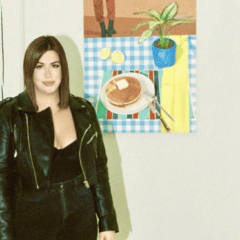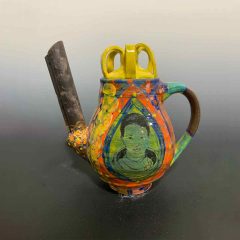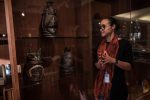Docu-Commencement at Bryn Mawr College commemorates the 2011 graduation at the college and captures thoughts about students leaving a place of shelter for the world beyond. For the show, Brian Wallace, Bryn Mawr College Curator and Academic Liaison for Art and Artifacts, commissioned four artists — James Johnson, Jennifer Levonian, Kay Healy and Gilbert Plantinga — to be in residence for 24 hours over the commencement weekend and to make work based on that residency. For the artists it was an opportunity to meet students and perhaps revisit their own college commencement experience.
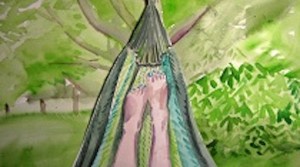
The resulting exhibit features the commissioned works by the four artists — installation, video, animation, photography and prints. All the works are great, and for the three artists whose works I know, I can say that, theme commission or not, the work made is directly in the oeuvre of the maker, not something tossed off to fulfill a promise. Indeed nothing is tossed off here, and everything is very much considered, in the best way. There is something inspired about commissioning work in this fashion. Curator Wallace is to be congratulated for the idea, and the artists for the great execution of wonderful new works.
Jennifer Levonian’s The Poetry Winner (2012) deals squarely with the idea of transitions. The stop-action animation narrative, made with watercolor drawings and paper cut-outs, uses the voices of Bryn Mawr students in the roles of (fictitious) graduates, which gives the video a terrific real world anchor. The short piece traces the journey of one graduate, the poetry winner, who returns home to a job in retail, which she hates. Whimsical, funny in parts, and astute in describing the return to the nest of a young person who doesn’t want to be there, the video is another terrific Jennifer Levonian story.
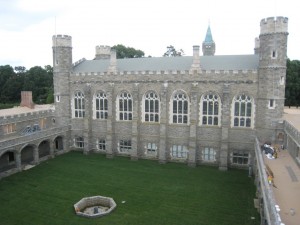
Less about transitions and more about the idea of a hallowed space, James Johnson’s peephole environment is one part Duchamp’s “Etante donnes” and all parts “Fountain.” The witty work looks like a tall, white-painted pedestal from the outside, and inside, a video plays a loop of a beloved campus fountain it’s water gushing quietly and steadily in the cloistered interior courtyard of Thomas Great Hall. There’s something so still and awe-filled about this piece that it becomes like a religious relic, a piece of the college forever saved in a memory box.
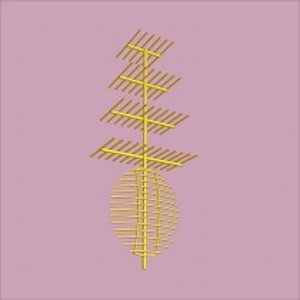
Johnson’s other works in the exhibit include a gold embroidered image of a tv antenna (a reference to a Venturi Scott Brown antenna proposed and then nixed for the Guild Hall building on Spring Garden St.). And sitting outside on the campus is another Johnson work, a non-table table, placed where students gather, awaiting their interaction. It’s a little too high to be a table, but I am guessing in time the beautiful wood structure will become a beloved perch to sit on or hide under.
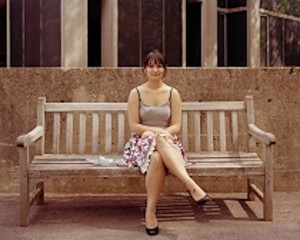
Families may not have been on Gilbert Plantinga’s mind when he was in residence, according to his essay in the show’s brochure, but family, and graduates are who are captured in the artist’s photos. Shot with a large format camera with painstaking setup time, the prints are still and quiet, the calm before the (presumed) storm of leave-taking. Plantinga also made a photo slide show that plays on a monitor. Instead of people pictures, the photos are of spaces on the campus, and the show is accompanied by a motion-activated mashup of music — Pomp and Circumstance and a Frank Zappa number, “Peaches en Regalia.” Not quite as wonderful as the photos of the graduates and families, but still a serious piece of work.
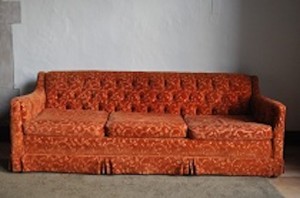
The surprise in the group is Kay Healy’s elegiac video and print, focused on a humble couch, a piece of furniture common to apartments and houses everywhere, including college common rooms. The couch pictured by Healy in her print is an interpretation of a real couch she found on the campus (pictured above), a rumpled red three-seater. Healy’s print, which sits at floor level seems almost life size (perhaps it is life size — it’s very big, and has a presence). She wheat pasted her print outside on some walls around the campus (apparently some students were not pleased), and she pasted it on one of the gallery walls for the exhibit. Above this sad-looking red couch is a projection of a video taken by the artist that shows a repeat loop of an abandoned grey couch being fed into and digested by a Philadelphia city garbage truck on trash day. The continuous loop of destruction in the video coupled with the forlorn and lonely print of the couch speaks of emotional upheaval and the violent separation brought on by the simple act of graduation. It’s almost heartbreaking.
I had never been on the Bryn Mawr campus before my trip to see Docu-Commencement, and I was taken by the varied face of the school, from buildings that seem typical 20th Century college campus to the Oxbridgean Gothic otherworld that exists beyond the stone archway. Quite a place, and I’d actually like to take an architecture tour if there is one, to find out about those old stone buildings as well as a couple modernist monsters that need some explaining.
Docu-Commencement is up to Dec. 14.


